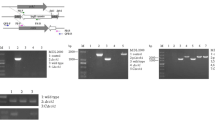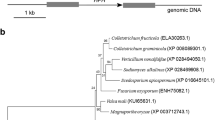Abstract
The high-osmolarity glycerol signal pathway plays an important role in the response of fungi to various environmental stresses. In this study, we characterized a mitogen-activated protein kinase kinase kinase gene BcOS4 in Botrytis cinerea, which is homologous to Saccharomyces cerevisiae SSK2/SSK22. The BcOS4 deletion mutant was significantly impaired in vegetative growth and conidial formation. The mutant exhibited increased sensitivity to the osmotic, oxidative stresses and to the fungicides iprodione and fludioxonil. Western blot analysis showed that BcSak1, a putative downstream component of BcOs4, was not phosphorylated in the mutant. In addition, the BcOS4 mutant was unable to infect leaves of rapeseed and cucumber, and grape fruits, although it can cause disease on apple fruits. All the defects were restored by genetic complementation of the BcOS4 deletion mutant with the wild-type BcOS4 gene. The data of this study indicate that BcOS4 is involved in vegetative differentiation, virulence, adaption to hyperosmotic and oxidative stresses, and to fungicides in B. cinerea.









Similar content being viewed by others
References
Avenot H, Simoneau P, Lacomi-Vasilescu B, Bataille-Simoneau N (2005) Characterization of mutations in the two-component histidine kinase gene AbNIK1 from Alternaria brassicicola that confer high dicarboximide and phenylpyrrole resistance. Curr Genet 47:234–243
Bahn Y (2008) Master and commander in fungal pathogens: the two-component system and the HOG signal pathway. Eukarot Cell 7:2017–2036
Bahn YS, Geunes-Boyer S, Heitman J (2007) Ssk2 mitogen-activated protein kinase kinase kinase governs divergent patterns of the stress-activated Hog1 signaling pathway in Cryptococcus neoformans. Eukaryot Cell 6:2278–2289
Banno S, Noguchi R, Yamashita K, Fukumori F, Kimura M, Yamaguchi I, Fujimura M (2007) Roles of putative His-to-Asp signaling modules HPT-1 and RRG-2 on viability and sensitivity to osmotic and oxidative stresses in Neurospora crassa. Curr Genet 51:197–208
Catlett NL, Yoder OC, Turgeon BG (2003) Whole-genome analysis of two component signal transduction genes in fungal pathogens. Eukaryot Cell 6:1151–1161
Cheetham J, Smith DA, DA Silva DA, Doris KS, Patterson MJ, Bruce CR, Quinn J (2007) A single MAPKKK regulates the Hog1 MAPK pathway in the pathogenic fungus Candida albicans. Mol Biol Cell 18:4603–4614
Cui W, Beever RE, Parkes SL, Weeds PL, Templeton MD (2002) An osmosensing histidine kinase mediates dicarboximide fungicide resistance in Botryotinia fuckeliana (Botrytis cinerea). Fungal Genet Biol 36:187–198
Cui W, Beever RE, Parkers SL, Templeton MD (2004) Evolution of an osmosensing histidine kinase in field strains of Botryotinia fuckeliana (Botrytis cinerea) in response to dicarboximide fungicide usage. Phytopathology 94:1129–1135
Dixon KP, Xu JR, Smirnoff N, Talbot NJ (1999) Independent signaling pathways regulate cellular turgor during hyperosmotic stress and appressorium-mediated plant infection by Magnaporthe grisea. Plant Cell 11:2045–2058
Doehlemann G, Berndt P, Hahn M (2006) Different signaling pathways involving a Gα protein, cAMP and a MAP kinase control germination of Botrytis cinerea conidia. Mol Microbiol 59:821–835
Dohlman HG (2002) G proteins and pheromone signaling. Annu Rev Physiol 64:129–152
Fujimura M, Ochiai N, Oshima M, Motoyama T, Ichiishi A, Usami R, Horikoshi K, Yamaguchi I (2003) Putative homologs of SSK22 MAPKK kinase and PBS2 MAPK kinase of Saccharomyces cerevisiae encoded by os-4 and os-5 genes for osmotic sensitivity and fungicide resistance in Neurospora crassa. Biosci Biotechnol Biochem 67:186–191
Geer LY, Domrachev M, Lipman DJ, Bryant SH (2002) CDART: protein homology by domain architecture. Genome Res 12:1619–1923
Gustin MC, Albertyn J, Alexander M, Davenport K (1998) MAP kinase pathways in the yeast Saccharomyces cerevisiae. Microbiol Mol Biol Rev 62:1264–1300
Henkel E, Stoltz M (1982) A newly drafted colour test for the determination of triglycerides convenient for manual and mechanized analysis (glycerolphosphate-oxidase-PAP method). Fresenius Z Anal Chem 311:451–452
Hohmann S (2002) Osmotic stress signaling and osmoadaptation in yeasts. Microbiol Mol Biol Rev 66:300–372
Igbaria A, Lev S, Rose MS, Lee BN, Hadar R, Degani O, Horwitz BA (2008) Distinct and combined roles of the MAP kinases of Cochliobolus heterostrophus in virulence and stress responses. Mol Plant Microbe Interact 21:769–780
Jones CA, Greer-Phillips SE, Borkovich KA (2007) The response regulator RRG-1 functions upstream of a mitogen-activated protein kinase pathway impacting asexual development, female fertility, osmotic stress, and fungicide resistance in Neurospora crassa. Mol Biol Cell 18:2123–2136
Kojima K, Takano Y, Yoshimi A, Tanaka C, Kikuchi T, Okuno T (2004) Fungicide activity through activation of a fungal signaling pathway. Mol Microbiol 53:1785–1796
Krantz M, Becit E, Hohmann S (2006) Comparative analysis of HOG pathway proteins to generate hypotheses for functional analysis. Curr Genet 49:152–165
Lew RR (2010) Turgor and net ion flux responses to activation of the osmotic MAP kinase cascade by fludioxonil in the filamentous fungus Neurospora crassa. Fungal Genet Biol 47:721–726
Liu X, Lu JP, Zhang L, Dong B, Min H, Lin FC (2007) Involvement of a Magnaporthe grisea serine/threonine kinase gene, MgATG1, in appressorium turgor and pathogenesis. Eukaryot Cell 6:977–1005
Liu W, Leroux P, Fillinger S (2008) The HOG1-like MAP kinase Sak1 of Botrytis cinerea is negatively regulated by the upstream histidine kinase Bos1 and is not involved in dicarboximide- and phenylpyrrole-resistance. Fungal Genet Biol 45:1062–1074
Liu W, Soulie MC, Perrino C, Fillianger S (2011) The osmosensing signal transduction pathway from Botrytis cinerea regulates cell wall integrity and MAP kinase pathways control melanin biosynthesis with influence of light. Fungal Genet Biol 48:377–387
Livak KJ, Schmittgen TD (2001) Analysis of relative gene expression data using real-time quantitative PCR and the 2–ΔΔCt method. Methods 25:402–408
Ma Z, Luo Y, Michailides TJ (2006) Molecular characterization of the two-component histidine kinase gene from Monilinia fructicola. Pest Manag Sci 62:991–998
Ma Z, Yan Y, Luo Y, Michaildes TJ (2007) Sequence variation in the two-component histidine kinase gene of Botrytis cinerea associated with resistance to dicarboximide fungicides. Pesticide Biochem Physiol 88:300–306
Maeda T, Takekawa M, Saito H (1995) Activation of yeast PBS2 MAPKK by MAPKKKs or by binding of an SH3-containing osmosensor. Science 269:554–558
McDonald BA, Martinez JP (1990) Restriction fragment length polymorphisms in Septoria tritici occur at high frequency. Curr Genet 17:133–138
Mehrabi R, Zwiers L, de Waard M, Kema GHJ (2006) MgHog1 regulates dimorphism and pathogenicity in the fungal wheat pathogen Mycosphaerella graminicola. Mol Plant Microbe Interact 19:1262–1269
Moriwaki A, Kubo E, Arase S, Kihara J (2006) Disruption of SRM1, a mitogen-activated protein kinase gene, acts sensitivity to osmotic and ultraviolet stressors in the phytopathogenic fungus Bipolaris oryzae. FEMS Microbiol Lett 257:253–261
Mullins ED, Chen X, Romaine P, Raina R, Geiser DM, Kang S (2001) Agrobacterium-mediated transformation of Fusarium oxysporum: an efficient tool for insertional mutagenesis and gene transfer. Phytopathology 91:173–180
O’Rourke SM, Herskowitz I (1998) The Hog1 MAPK prevents cross talk between the HOG and pheromone response MAPK pathways in Saccharomyces cerevisiae. Gene Dev 12:2874–2886
Ochiai N, Fujimura M, Motoyama T, Ichiishi A, Usami R, Horijoshi K, Yamaguchi I (2002) Characterization of mutations in the two-component histidine kinase gene that confer fludioxonil resistance and osmotic sensitivity in the os-1 mutants of Neurospora crassa. Pest Manag Sci 57:437–442
Ochiai N, Tokai T, Nishiuchi T, Takahashi-Ando N, Fujimura M, Kimura M (2007) Involvement of the osmosensor histidine kinase and osmotic stress-activated protein kinases in the regulation of secondary metabolism in Fusarium graminearum. Biochem Bioph Res Co 363:639–644
Posas F, Saito H (1997) Osmotic activation of the HOG MAPK pathway via Ste11p MAPKKK: scaffold role of Pbs2p MAPKK. Science 276:702–1705
Posas F, Saito H (1998) Activation of the yeast SSK2 MAP kinase kinase kinase by the SSK1 two-component response regulator. EMBO J 17:1385–1394
Posas F, Wurgler-Murphy SM, Maeda T, Witten EA, Thai TC, Saito H (1996) Yeast HOG1 MAP kinase cascade is regulated by a multistep phosphorelay mechanism in the SLN1-YPD1-SSK1 “two-component” osmosensor. Cell 86:865–875
Raitt DC, Posas F, Saito H (2000) Yeast Cdc42 GTPase and Ste20 PAK-like kinase regulate Sho1-dependent activation of the Hog1 MAPK pathway. EMBO J 9:4623–4631
Reiser V, Salah SM, Ammerer G (2000) Polarized localization of yeast Pbs2 depends on osmostress, the membrane protein Sho1 and Cdc42. Nat Cell Biol 2:620–627
Rispail N, Soanes DM, Ant C, Czajkowski R, Grünler A, Huguet R, Perez-Nadales E, Poli A, Sartorel E, Valiante V, Yang M, Beffa R, Brakhage AA, Gow NAR, Kahmann R, Lebrun M, Lenasi H, Perez-Martin J, Talbot N, Wendland J, Di Pietro A (2009) Comparative genomics of MAP kinase and calcium–calcineurin signaling components in plant and human pathogenic fungi. Fungal Genet Biol 46:287–298
Rui O, Hahn M (2007) The Slt2-type MAP kinase Bmp3 of Botrytis cinerea is required for normal saprotrophic growth, conidiation, plant surface sensing and host tissue colonization. Mol Plant Pathol 8:173–184
San Jose C, Monge RA, Perez-Diaz R, Pla J, Nombela C (1996) The mitogen activated protein kinase homolog HOG1 gene controls glycerol accumulation in the pathogenic fungus Candida albicans. J Bacteriol 178:5850–5852
Santos JL, Shiozaki K (2001) Fungal histidine kinases. Sci STKE 98:1–14
Schamber S, Leroch M, Diwo J, Mendgen K, Hahn M (2010) The role of mitogen-activated protein (MAP) kinase signaling components and the Ste12 transcription factor in germination and pathogenicity of Botrytis cinerea. Mol Plant Pathol 11:105–119
Segmüller N, Ellendorf U, Tudzynski B, Tudzynski P (2007) BcSAK1, a stress-activated mitogen-activated protein kinase, is involved in vegetative differentiation and pathogenicity in Botrytis cinerea. Eukaryot Cell 6:211–221
Sweigard J, Chumley F, Carroll A, Farrall L, Valent B (1997) A series of vectors for fungal transformation. Fungal Genet Newslett 44:52–53
Viaud M, Fillinger S, Liu W, Polepalli JS, Le Pêcheur P, Kunduru AR, Leroux P, Legendre L (2006) A class III histidine kinase acts as a novel virulence factor in Botrytis cinerea. Mol Plant Microbe Interact 9:1042–1050
Vitalini MW, de Paula RM, Goldsmith CS, Jones CA, Borkovich KA, Bell-Pedersen D (2007) Circadian rhythmicity mediated by temporal regulation of the activity of p38 MAPK. Proc Natl Acad Sci USA 104:18223–18228
Williamson B, Bettina T, Paul T, Van Kan JAL (2007) Botrytis cinerea: the cause of grey mould disease. Mol Plant Pathol 8:561–580
Wojda I, Alonso-Monge R, Bebelman JP, Mager WH, Siderius M (2003) Response to high osmotic conditions and elevated temperature in Saccharomyces cerevisiae is controlled by intracellular glycerol and involves coordinate activity of MAP kinase pathways. Microbiology 149:1193–1204
Yan L, Yang Q, Sundin GW, Li H, Ma Z (2010) The mitogen-activated protein kinase kinase BOS5 is involved in regulating vegetative differentiation and virulence in Botrytis cinerea. Fungal Genet Biol 47:753–760
Yan L, Yang Q, Jiang J, Michailides TJ, Ma Z (2011) Involvement of a putative response regulator Brrg-1 in the regulation of sporulation, sensitivity to fungicides, and osmotic stress in Botrytis cinerea. Appl Microbiol Biotechnol 90:215–226
Yoshimi A, Tsuda M, Tanaka C (2004) Cloning and characterization of the histidine kinase gene Dic1 from Cochliobolus heterostrophus that confers dicarboximide resistance and osmotic adaptation. Mol Genet Genom 271:228–236
Zhang Y, Lamm R, Pillonel C, Lam S, Xu JR (2002) Osmoregulation and fungicide resistance: the Neurospora crassa os-2 gene encodes a HOG1 mitogen-activated protein kinase homologue. Appl Environ Microbiol 68:532–538
Acknowledgments
The research was supported by the 973 program (2012CB114004), the China Agriculture Research System (CARS-3-1-15), and the program for Changjiang Scholars and Innovative Research Teams in University (IRT0943).
Author information
Authors and Affiliations
Corresponding author
Electronic supplementary material
Below is the link to the electronic supplementary material.
ESM 1
(DOC 1218 kb)
Rights and permissions
About this article
Cite this article
Yang, Q., Yan, L., Gu, Q. et al. The mitogen-activated protein kinase kinase kinase BcOs4 is required for vegetative differentiation and pathogenicity in Botrytis cinerea . Appl Microbiol Biotechnol 96, 481–492 (2012). https://doi.org/10.1007/s00253-012-4029-9
Received:
Revised:
Accepted:
Published:
Issue Date:
DOI: https://doi.org/10.1007/s00253-012-4029-9




